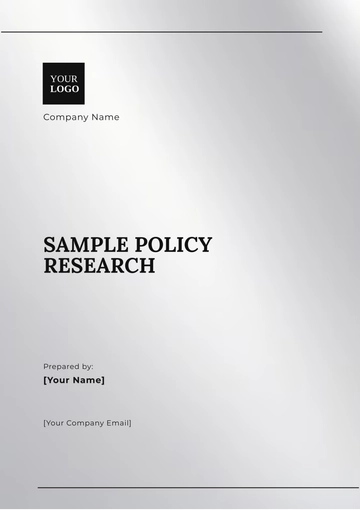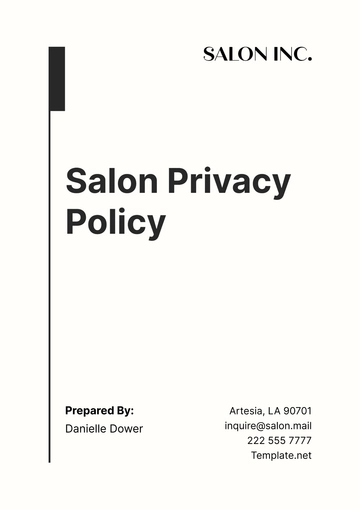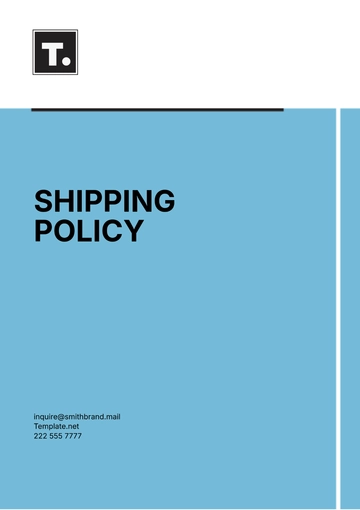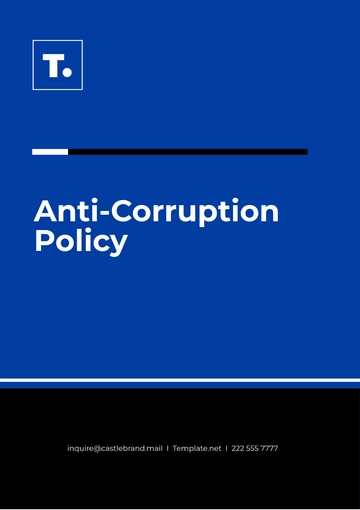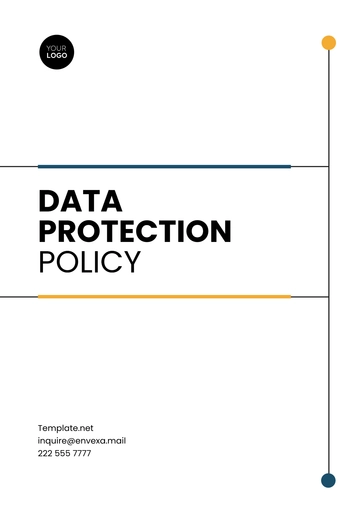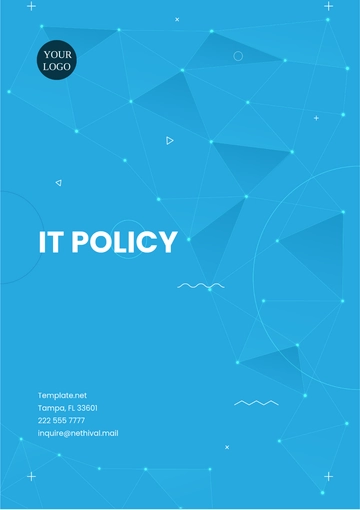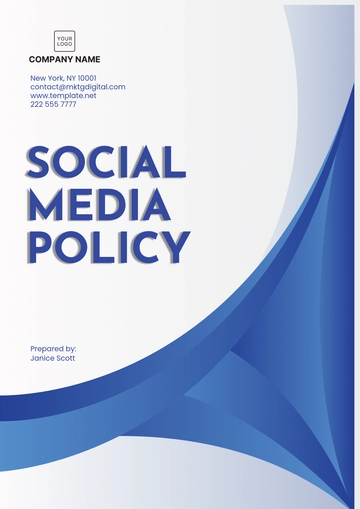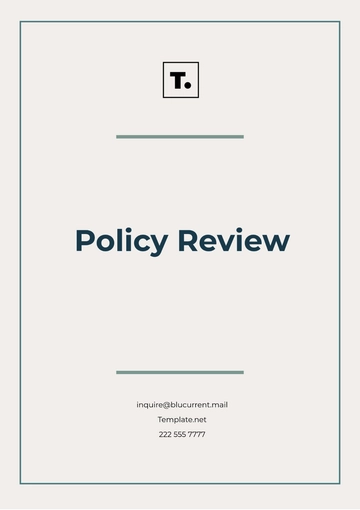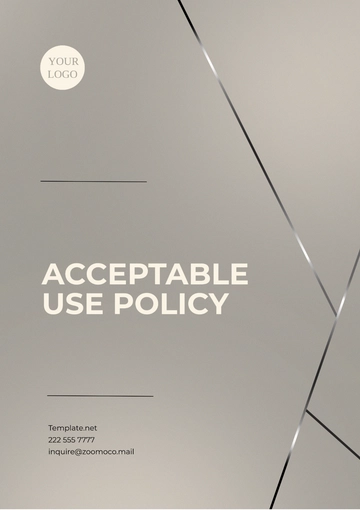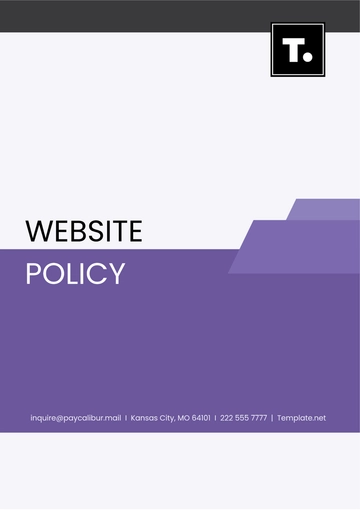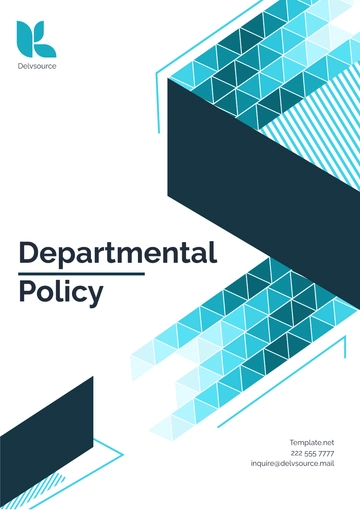Free Sales Policy on Managing Customer Feedback

I. Introduction
At [Your Company Name], we understand that customer feedback is a cornerstone of our business’s growth and sustainability. It is a critical input for continuous quality improvement, customer satisfaction, and innovation. This policy outlines our approach to managing customer feedback, ensuring that every voice is heard and contributes to our mission of delivering excellence in all aspects of our operations.
It emphasizes our commitment to creating a transparent and responsive environment where feedback is actively sought, meticulously analyzed, and systematically utilized to drive organizational and product improvements.
II. Purpose
The objective of this policy is to codify a consistent and formalized approach to the acquisition, processing, and utilization of customer feedback within [Your Company Name]. Our intention is to secure a structured mechanism that not only facilitates the expedient and proficient management of such feedback but also underscores its pivotal role in augmenting customer satisfaction levels, elevating the caliber of our service, and refining our product portfolio.
III. Scope
This policy is applicable and obligatory for the entire personnel of [Your Company Name]. Our sales associates, customer support teams, and executive management are all entrusted with the responsibilities delineated by this policy. Each employee, irrespective of their position or department, is equipped and expected to uphold the standards prescribed herein.
IV. Definitions
To ensure a distinct communication and to foster uniform comprehension throughout the organizational strata of [Your Company Name], the subsequent terminologies are elucidated:
A. Feedback
This refers to any expression of evaluation, whether positive, negative, or neutral, communicated to us by customers. Feedback encompasses a broad spectrum of customer inputs, including direct observations, subjective opinions, constructive criticisms, commendations, or specific suggestions related to the company’s products, services, customer experiences, or any other aspect of our business operations.
B. Customer Satisfaction Index (CSI)
This is a quantifiable metric that gauges the degree of contentment a customer experiences with respect to a particular aspect of our business, or with our products and services as a whole. The CSI is derived from systematic analysis of customer feedback and is instrumental in assessing the performance of the company from the customer’s perspective.
C. Constructive Suggestions
These are proactive recommendations provided by customers that aim to propose practical improvements or solutions to perceived issues or to enhance the existing products, services, or processes.
D. Complaint Resolution Timeframe
This is the period within which a customer's complaint or grievance is expected to be fully addressed and resolved, starting from the time it is received to the time a resolution is communicated and accepted by the customer.
E. Customer Feedback Management System (CFMS)
A designated software system or set of procedures used by the company to document, track, analyze, and report on customer feedback. This system is integral to managing the customer feedback lifecycle and ensuring accountability and follow-through on all feedback received.
These definitions are critical for the effective application of this policy and to foster an environment where customer feedback is systematically managed and valued as a key driver for business improvement and innovation.
V. Procedure
The methodology for managing customer feedback at [Your Company Name] is delineated in a multi-step process designed to capture, evaluate, and respond to customer insights systematically. This procedure ensures that each piece of feedback travels through an organized pathway from reception to resolution:
Step | Action | Responsible Party | Timeframe |
1 | Collection of Feedback | All Customer-Facing Personnel | Immediate upon receipt |
2 | Systematic Logging and Categorization | Customer Feedback Management Team | Within 24 hours of receipt |
3 | In-depth Analysis and Strategic Synthesis | Data Analysis and Insights Department | Bi-weekly Analysis |
4 | Development of Response and Corrective Measures | Customer Experience Improvement Committee | Within 5 business days of analysis |
5 | Execution of Enhancements and Solutions | Relevant Operational Teams | Scheduled as per response plan |
6 | Ongoing Monitoring and Impact Assessment | Quality Assurance and Compliance Teams | Continuous with formal reviews at the end of each quarter |
7 | Reporting to Management and Stakeholders | Customer Feedback Management Team | Monthly and Quarterly Reports |
8 | Archiving and Documentation for Future Reference | Information Management Specialists | After each reporting cycle |
The above table represents a high-level overview of our management process. Each step is integral to the policy's efficacy and is designed to foster an environment of continuous improvement within [Your Company Name].
Step-specific details are outlined as follows:
A. Collection of Feedback
The initial contact points for feedback include, but are not limited to, customer service interactions, sales experiences, digital platforms, and direct communication channels. Employees are trained to actively listen and accurately record customer sentiments.
B. Systematic Logging and Categorization
Each piece of feedback is logged into the Customer Feedback Management System to ensure no customer insight is overlooked. The feedback is then categorized by nature and urgency to streamline subsequent analysis and action.
C. In-depth Analysis and Strategic Synthesis
The Data Analysis and Insights Department performs a comprehensive analysis, identifying patterns and pinpointing areas for improvement, which in turn, helps prioritize action items.
D. Development of Response and Corrective Measures
The Customer Experience Improvement Committee, consisting of cross-functional leadership, devises targeted response strategies and corrective measures to address the feedback.
E. Execution of Enhancements and Solutions
Implementation of the response plan is managed by the respective operational teams who are tasked with enacting the improvements, guided by the specified timelines and objectives.
F. Ongoing Monitoring and Impact Assessment
Quality Assurance and Compliance Teams engage in ongoing monitoring of the implemented changes, assessing the impact and ensuring the desired outcomes align with customer expectations.
G. Reporting to Management and Stakeholders
Monthly and Quarterly reports are prepared by the Customer Feedback Management Team, which includes insights on customer satisfaction, feedback trends, and the status of improvement initiatives.
H. Archiving and Documentation for Future Reference
Documentation and archival procedures are executed to maintain a historical record of customer feedback and the organization’s responses, ensuring a repository for longitudinal analysis and regulatory compliance.
VI. Feedback Analysis and Reporting
The examination and communication of customer feedback are critical components in the feedback management lifecycle. This phase involves sophisticated analysis and detailed reporting mechanisms that provide the foundation for informed decision-making and strategic planning.
A. Feedback Analysis
Quantitative Analysis: Using advanced statistical tools and methodologies, the Data Analysis and Insights Department quantitatively assesses feedback for trends, frequency, and sentiment scoring.
Qualitative Analysis: Qualitative insights are extracted through thematic content analysis, allowing for the identification of underlying issues, expectations, and customer perceptions.
Comparative Analysis: Customer feedback is evaluated against benchmark data, both historical and industry-wide, to determine the company’s performance relative to market standards and competitors.
Outcome Synthesis: The culmination of these analytical efforts is synthesized into actionable intelligence, pinpointing specific areas for improvement, highlighting strengths to be leveraged, and identifying opportunities for innovation.
B. Feedback Reporting
Internal Reporting: Regular, detailed reports are compiled and distributed internally to relevant stakeholders. These reports include an executive summary, detailed findings, and clear recommendations for actions.
Performance Dashboards: Interactive dashboards are maintained in real-time, providing an at-a-glance view of key customer feedback metrics. This facilitates ongoing monitoring by the management and employees.
Actionable Insight Distribution: A process is in place to distribute insights to the appropriate teams. This ensures that the intelligence gathered is converted into concrete action plans for service improvement, product development, and customer experience enhancement.
Stakeholder Presentations: Quarterly and annual feedback presentations are made to senior management and key stakeholders, providing an overarching view of customer feedback trends, the effectiveness of strategies implemented, and guidance for future policy adjustments.
External Reporting: Customer feedback metrics and success stories are featured in annual reports and shareholder briefings, underscoring the company's commitment to customer-centricity and transparency.
Documentation and Archiving: Comprehensive records of all customer feedback, analysis processes, and reporting are meticulously documented and archived. This is not only for the purpose of historical reference but also serves as a compliance measure.
VII. Responsibilities
The implementation of this policy at [Your Company Name] necessitates clearly defined roles and responsibilities. This ensures that all employees understand their obligations in the feedback management process and are accountable for their part in maintaining the highest standards of customer service.
A. Customer-Facing Employees
Actively solicit feedback during customer interactions.
Record feedback accurately and promptly in the Customer Feedback Management System.
Display professionalism and empathy when addressing customer concerns.
B. Customer Feedback Management Team
Oversee the CFMS and ensure all feedback is correctly logged and assigned for analysis.
Collaborate with the Data Analysis and Insights Department to prioritize feedback items based on urgency and impact.
Prepare and distribute feedback reports to relevant stakeholders.
C. Data Analysis and Insights Department
Conduct thorough and unbiased analysis of customer feedback.
Translate data into meaningful insights and actionable recommendations.
Regularly update the Customer Experience Improvement Committee on emerging trends and areas requiring attention.
D. Customer Experience Improvement Committee
Develop strategic plans and corrective actions based on feedback analysis.
Ensure cross-departmental collaboration in implementing feedback-driven initiatives.
Review and approve final action plans and oversee the monitoring of their effectiveness.
E. Quality Assurance and Compliance Teams
Monitor the execution of feedback-related actions and assess their effectiveness.
Ensure that all feedback management activities adhere to industry standards and regulatory requirements.
Provide compliance reports to management on a regular basis.
F. Information Management Specialists
Securely archive all feedback and reports in accordance with data protection laws and company policies.
Facilitate easy retrieval of records for analysis, reporting, and regulatory purposes.
G. Senior Management and Key Stakeholders
Review and evaluate quarterly and annual feedback summaries.
Support a company culture that values and utilizes customer feedback.
Allocate resources for the implementation of feedback-driven improvements.
VIII. Training
To systematize the training for effective customer feedback management, [Your Company Name] has developed a structured schedule that outlines the timing and content of the training modules. This schedule is implemented annually and is subject to updates based on evolving needs and feedback.
Module | Audience | Duration |
Orientation and Onboarding | New Employees | 2 Days |
Communication and Empathy | Customer-Facing Staff | 1 Day |
Analytical Techniques | Data Analysis Department | 2 Days |
Policy and System Updates | All Employees | 2 Hours |
Performance Coaching | All Employees | Varies |
Leadership and Decision-Making | Management and Leadership Teams | 3 Days |
Compliance and Best Practices | Compliance Teams | 2 Days |
Refresher Courses | All Employees | 1 Day |
Note: The duration of each module is an initial estimate and can be adjusted based on specific departmental needs and the pace at which participants are able to absorb the material.
[Your Company Name] is dedicated to ensuring that this schedule is adhered to, providing employees with the necessary resources and time to attend these training sessions. The effectiveness of these training modules is regularly evaluated through assessments and feedback from the participants, allowing for continuous improvement of the training program itself.
IX. Review and Improvement
This policy will be reviewed annually to ensure it remains effective and relevant. Improvements will be made based on insights gained from customer feedback and the effectiveness of previous action plans.
X. Policy Approval
This policy is approved by the Board of Directors of [Your Company Name] and is effective from [Month Day, Year]. It will be reviewed and updated as necessary, with the next review due by [Month Day, Year].
This policy shall be distributed to all employees and shall be accessible in the company’s policy repository. Compliance with this policy is mandatory for all staff members.
- 100% Customizable, free editor
- Access 1 Million+ Templates, photo’s & graphics
- Download or share as a template
- Click and replace photos, graphics, text, backgrounds
- Resize, crop, AI write & more
- Access advanced editor
Manage your customer feedback effectively with our Sales Policy on Managing Customer Feedback Template! This fully editable and customizable policy from Template.net ensures you capture every important detail. Our advanced AI Editor Tool makes editing seamless, helping you create a comprehensive policy that values and respects customer feedback! Download immediately!
You may also like
- HR Policy
- Restaurant Policy
- Company Policy
- Accounting Policies and Procedures
- Website Policy
- Privacy Policy
- Safety Policy
- School Policy
- IT and Software Policy
- Law Firm Policy
- Construction Policy
- Interior Design Policy
- Travel Agency Policy
- Education Academic Policy
- Security Policy
- Real Estate Policy
- Expense Policy
- Software Policy
